Ecommerce ‘Psychology of Product Reviews’ Survey 2021
In 2021, we wanted to discover some of the psychology behind what makes people more or less likely to buy products online. So, we put together a series of questions, giving consumers unique buying scenarios in relation to product ratings and reviews, to see what choices they would make, in an effort to discover what they look for when researching products and deciding which ones to buy.
After surveying a broad spectrum of US adults, we discovered some fascinating results! Several of the answers we received were significantly different from what we had anticipated. However, the results also supported two core principles of Behavioral Psychology:
1. Popularity or Herd Behavior: People generally feel safer following the herd, and buying the most popular product, which is often signaled by more reviews.
2. Risk Avoidance: People avoid risk by using a high average star rating and more reviews to make both safe and popular purchasing decisions.
It just goes to show you that buying behavior online is still rooted in the same basic psychology that has always worked to improve sales.
The following information contains the full survey results, along with our analysis of those results.
Enjoy!
DJ Spraque
Chief Marketing Officer
Shopper Approved
Table of Contents
Buying Frequency, Review Importance, and Influence
How often do you buy products online?
How important are ratings and reviews when searching for products online?
How often do you read reviews when searching for a product online?
I read online ratings and reviews approximately ___% of the time before buying a product online.
What level of influence do online reviews have on your buying decisions?
Review Psychology - Different Scenarios
77% of the respondents selected one of the companies with 4.5 stars or higher as the company they would feel most comfortable buying from.
Consumers are much more likely to buy from a company with reviews ranging between 4.5-5 stars.
Over 2.5x more participants chose 5 stars over the next highest option
Review quantity is very important to a large group of buyers
What is the bare minimum number of reviews that a product has to have in order for you to be willing to buy it?
What is the bare minimum overall star rating that a product has to have in order for you to be willing to buy it?
How much does the total number of reviews that a product has, influence your buying decision?
How much does the number of reviews that a product has, influence your buying decision?
How much does the overall star rating that a product has, influence your buying decision?
How often do you leave a product review, when asked after making a purchase?
Summary of Findings
Methodology
Key Statistics of Psychology of Product Reviews
- 80% of consumers say that product ratings and reviews are important when searching for products online, with 61% saying they are ‘very important’ or ‘absolutely essential’.
- 69% of consumers read product reviews ‘most of the time’ or ‘always’ when searching for products online.
- 81% of consumers read product reviews 50% or more of the time before buying a product, and over 1/3rd (35%) of consumers read reviews over 90% of the time before buying.
- 68% of consumers say that online product reviews have either a ‘high’ or ‘very high’ influence on their buying decisions.
- When given different combinations of descending ratings and ascending number of product reviews, 77% of consumers chose product review combinations with 4.5-star ratings or higher, even if the number of reviews was exponentially higher when combined with lower ratings.
- When given complimentary ascending combinations of star ratings and number of product reviews, 31% chose the highest possible combination - over 2.5x more than the next highest combination.
- When given a fixed number of product reviews across a range of different star ratings, over 34% chose the highest possible star rating (5 stars).
- When given a fixed 4.5-star rating and a range of a different number of product reviews, 25% chose the highest possible number of reviews - approximately 3-5x more than all the other options.
- There are 5 distinct groups of consumers who are only willing to buy at certain review quantity levels: >25, <50, <100, <500, and <1000 reviews. To unlock the buying potential of all 5 consumer groups, a product needs to have over 1000 reviews.
- When asked the bare minimum overall star rating needed to buy a product, we discovered that there are 2 groups - a smaller risk-tolerant group who was willing to buy at 4.0 stars, and a much larger risk-averse group who was only willing to buy if products had a 4.5-star rating or higher.
- When asked what their ideal overall star rating was for a product, 25% said 5 stars - significantly more than any other star rating, with 80% saying that their ideal star rating was 4.5 stars or higher.
- 2 out of 3 people surveyed (66%) said that the total number of reviews a product has, ‘highly’ or ‘very highly’ influences their buying decision.
- 72% of those surveyed said that the overall star rating of a product has, ‘highly’ or ‘very highly’ influences their buying decision.
- When asked how often they leave a product review, 43% of consumers said ‘often’ or ‘always’.
Buying Frequency, Review Importance, and Influence
To get started, we asked consumers some high-level questions to get an idea of how often they buy online, and how important and influential product reviews are during the research and buying phases of their shopping experience.
How often do you buy products online?
Since this is an eCommerce survey, we started with a basic question to determine how often people bought online. While 24% said they buy less than once a week, 76% said they purchased at least once per week, with 38% saying they bought online 3 or more times per week.

In 2018, Statista published a survey stating that only 20% of online consumers bought one or more times per week, with 80% stating that they bought less than once a week. When you compare our new survey results to those of 2018, it shows that there is a major increase in online shopping frequency over the past 3 years. This rate has very likely been accelerated due to Covid-19. It will be interesting to see if buying frequency goes up or down a year from now, or if buying more frequently online is the new normal.
How important are ratings and reviews when searching for products online?
We asked this question to determine the level of value that consumers currently place on ratings and reviews during the research phase of the buyer journey. 61% of those surveyed said that ratings and reviews are ‘Very Important’ or “Absolutely Essential’ when searching for products to buy.
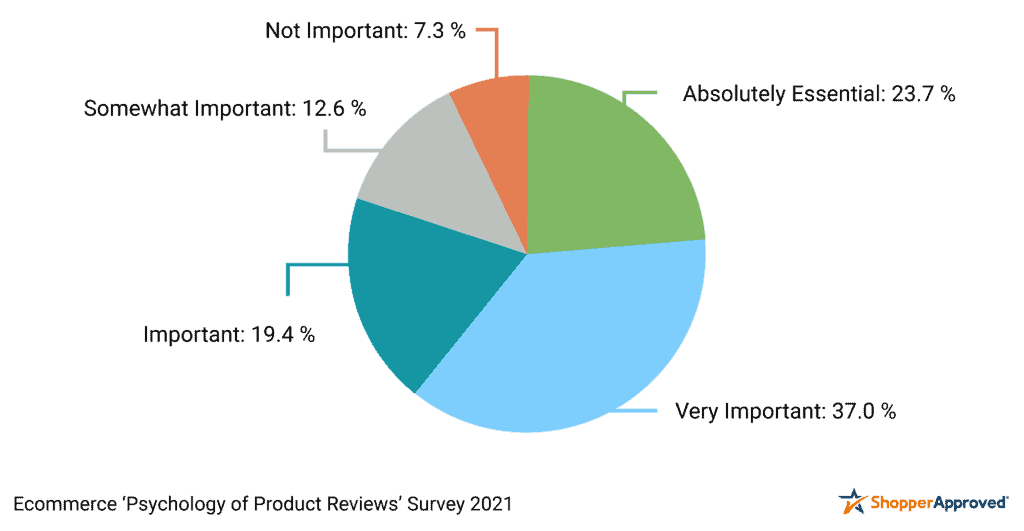
An additional 19% said they were ‘Important’, which means that 80% of shoppers place a great deal of value on ratings and reviews when trying to determine which products look the most trustworthy and credible.
How often do you read reviews when searching for a product online?
According to the survey, over 1/3rd (34%) of consumers said that they ‘Always’ read reviews when searching for a product online. In addition, another 1/3rd (35%) said that they read product reviews ‘Most of the time’.
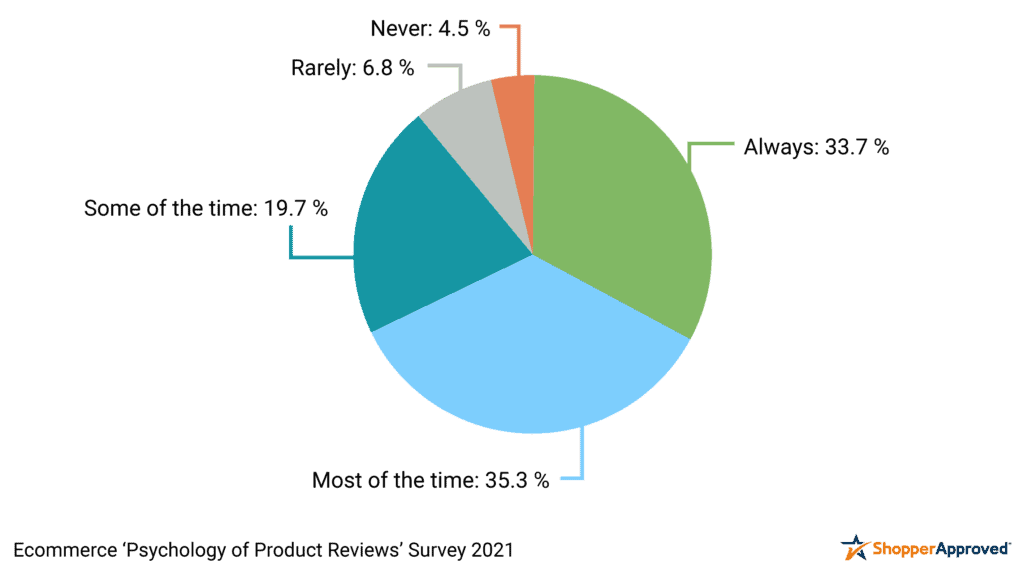
If you add the additional 20% who read reviews ‘Some of the time’, then 89% of online shoppers read reviews on some significant level when determining which products are credible. What this means to eCommerce site owners is that product ratings and reviews - both off-site and on-site - are very important, because nearly 9 out of 10 consumers read product reviews some, most, or all of the time.
I read online ratings and reviews approximately ___% of the time before buying a product online.
For this question, we wanted to see if there was a correlation between reading reviews when searching for a product and actually buying a product. (In the survey we bolded the words searching and buying to try to emphasize the difference.) We also chose to ask this question in a percentage format mostly out of curiosity to see what percentage of people would physically enter. The results are very interesting…
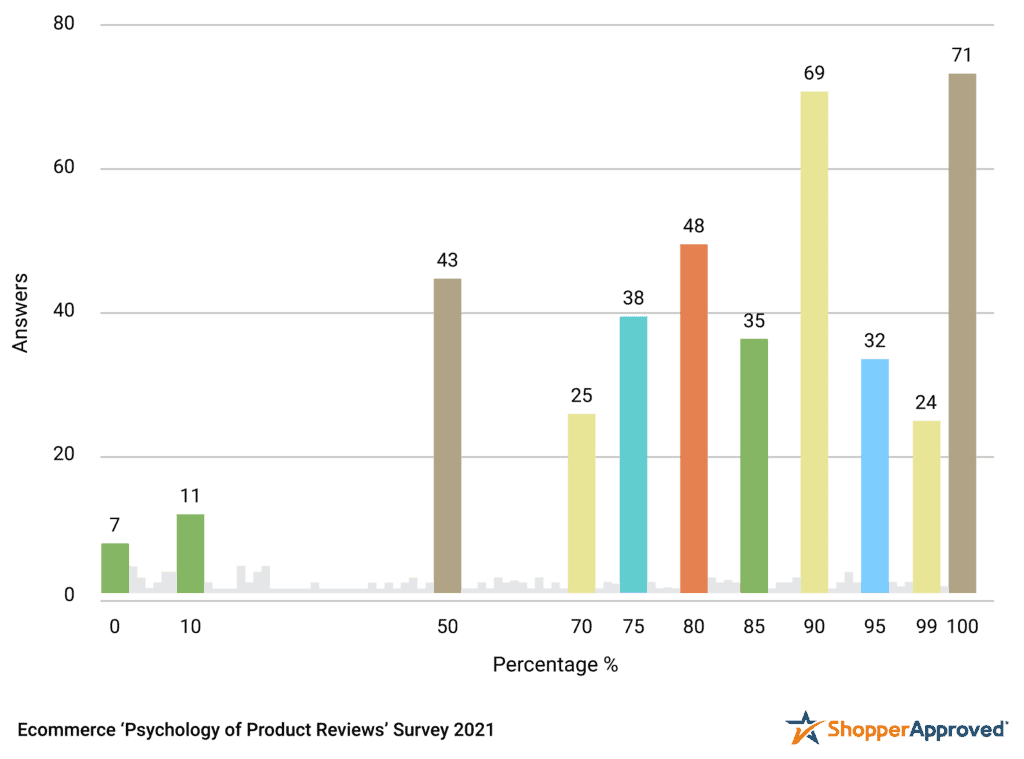
As you can see, there is a very noticeable increase in the number of consumers reading reviews once you hit 70%. There is also a spike at 50%. When you correlate the previous question’s data with this one, you get a high correlation of the consumers who said that they read reviews ‘Some of the time’ with those who entered 50% on this question. Likewise, a large number of those who said they read reviews ‘Most of the time’ entered percentages ranging between 70-90%. And finally, most of those surveyed who said they read reviews ‘All of the time, entered percentages between 90-100%.
Surprisingly, 81% of those surveyed stated that they read online ratings and reviews before making a purchase 50% or more of the time.
On a scale of 1-5, what level of influence do online reviews have on your buying decisions?
In this question, we wanted to see how much influence ratings and reviews had on consumer buying decisions. We had already asked about their importance, now we wanted to determine the influence reviews had on actually getting consumers to pull the trigger and buy.
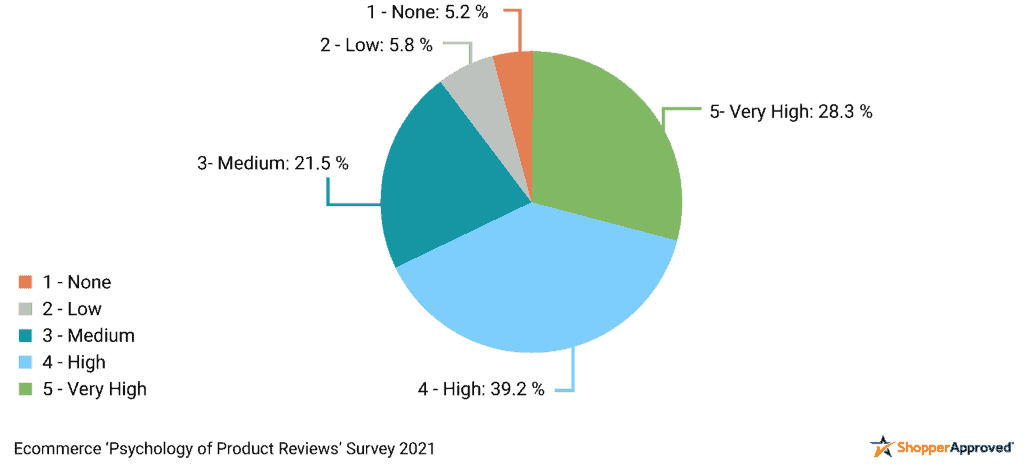
As you can see, for nearly 7 out of 10 consumers (or 68%), ratings and reviews have a ‘High’ or ‘Very High’ level of influence on buying decisions. This means that if you don’t have ratings and reviews - specifically ratings and reviews on your website’s product pages, your business will very likely suffer, because more and more, consumers won’t buy without them.
Review Psychology - Different Scenarios
At this point, we wanted to provide consumers with some unique rating and review scenarios, to see what they would pick when given certain conditions and circumstances. As we watched the results come in, we were very surprised by the findings.
If multiple companies sold the same product online for the same price, but their ratings and reviews were different, which combination of star ratings and number of reviews would make you most comfortable buying the product?
In this question, we wanted to see what would happen if the highest star ratings had the lowest number of reviews, and the lowest ratings had the highest number of reviews - which combination of star ratings and reviews would consumers gravitate to?
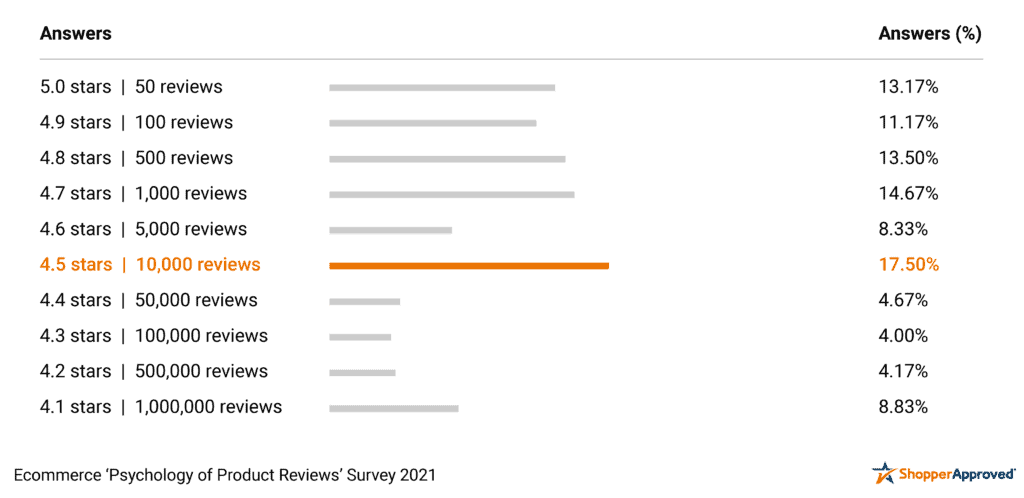
We started off with 5-stars and 50 reviews, and gradually lowered the star rating while significantly increasing the review quantity until we reached a 4.1-star rating with 1,000,000 reviews.
At the end of the survey, the sweet spot, or most popular response was 4.5 stars with 10,000 reviews. As you can see from the chart, 4.1 to 4.4 stars were the least picked, even though the number of reviews was exponentially larger. Even with the massive numbers of reviews, 77% of the respondents selected one of the companies with 4.5 stars or higher as the company they would feel most comfortable buying from.
If multiple companies sold the same product online for the same price, but their ratings and reviews were different, which combination of star ratings and number of reviews would make you most comfortable buying the product?
This question is similar to the previous question, but instead of decreasing the number of ratings and increasing the number of reviews, we increased the number of ratings and the number of reviews together, to see if there was a point where the ratings and reviews combined were ‘too good to be true'. To our surprise, there wasn’t such a point.
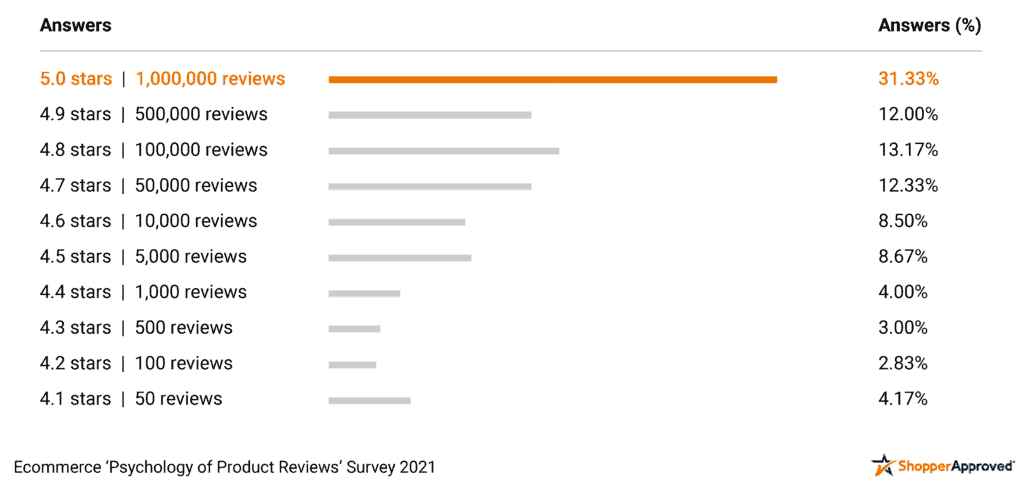
We actually expected the results to look more like a bell curve as the data approached the 5-star/1 million option, but what actually happened was that nearly 1/3rd of the participants actually chose it, making it far outweigh all the other options. What this tells us is that people still choose, or at least want to choose 5-star companies with large quantities of reviews. Even with fake reviews becoming an ever-growing concern, they still seem to trust that a company with a perfect 5-star rating and a ton of reviews can be legitimate.
Another interesting observation is that, just like with the previous question, we see a very noticeable jump at 4.5 stars and up. When you consider the ramifications of these two questions, it becomes apparent that consumers are much more likely to buy from a company with reviews ranging between 4.5-5 stars.
If multiple companies had the same product with the same number of reviews, but different star ratings, which company would you feel most comfortable buying from?
For this question, we wanted to isolate the impact of star ratings alone to see what options consumers would choose if the number of reviews was equal across multiple companies or sellers, but their average star rating was different. So we listed 11 options, from 5.0 down to 4.0 stars - all with 1,000 reviews each. Once again, we anticipated a bell curve as the data approached 5 stars, but just the opposite happened.
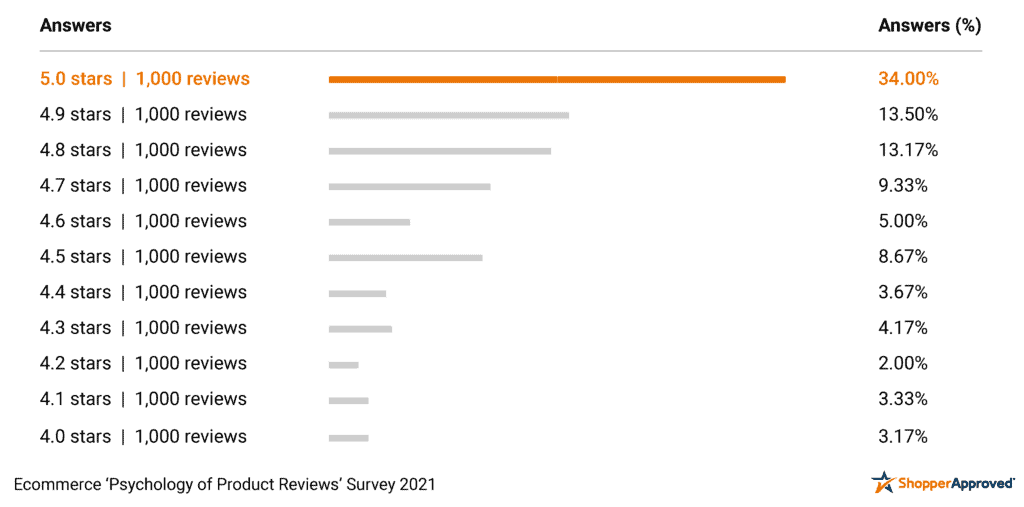
Over 2.5x more participants chose 5 stars over the next highest option. This reconfirmed to us that, even with all the review manipulation online, most consumers still want to see companies display the perfect 5-star rating when shopping online, and are more likely to buy from companies that display higher star ratings.
If multiple companies had the same 4.5-star rating, but different numbers of reviews, which company would you feel most comfortable buying from?
For this question, we showed several companies all with a 4.5-star rating, but with different review counts, from 1 to 1 million, to see if there was an ideal number of reviews, and also if there was a point of diminishing returns when it came to reviewing quantity.
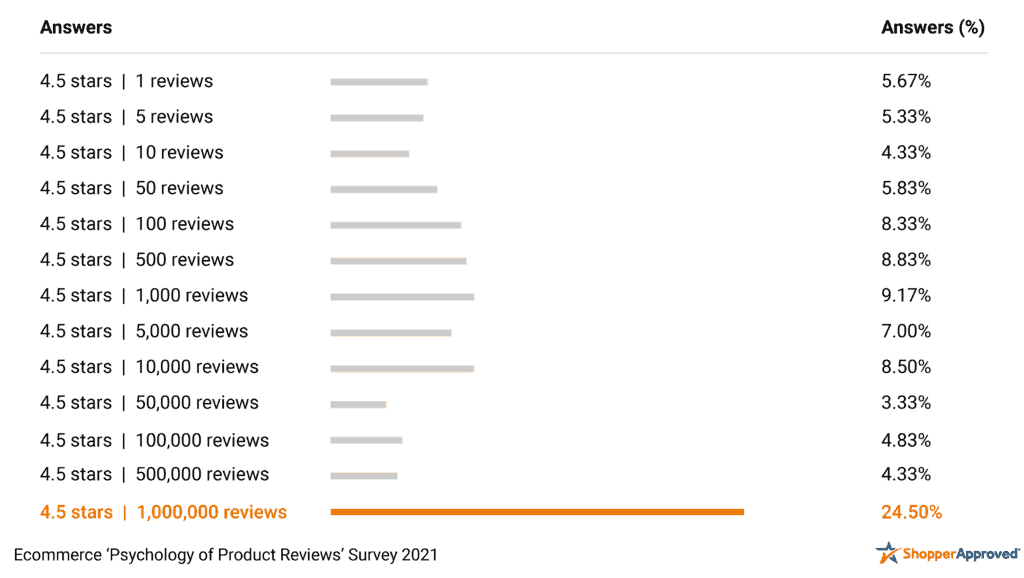
It turns out that there does appear to be a small bell-shaped curve, ranging between 100 to 10,000 reviews, with 500-1,000 reviews being at the center of the curve. However, there is also a massive spike in the 1 million range, with 25% of the respondents selecting that option. This tells us that review quantity is very important to a large group of buyers, and that if star ratings are similar between various competing sellers, this group of buyers will choose the company with the largest number of reviews.
What is the bare minimum number of reviews that a product has to have in order for you to be willing to buy it?
This question also yielded another interesting result we weren’t expecting. Respondents were able to enter any number between 1-1000 reviews. When we tabulated the data it revealed that there are 5 distinct groups or tiers of buyers:
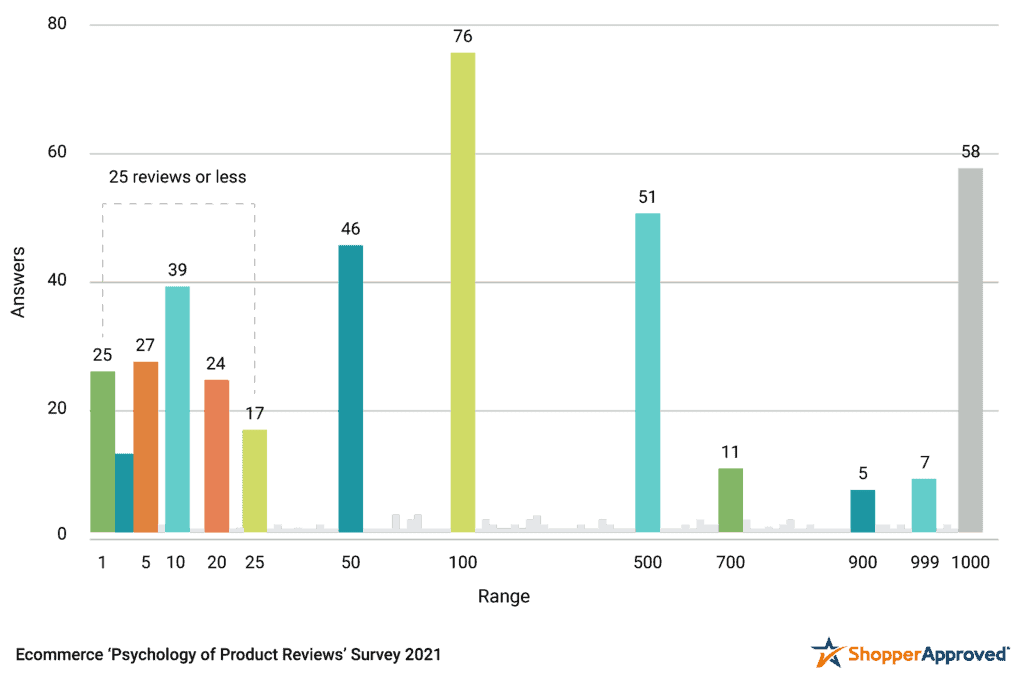
The first tier is actually a cluster of buyers who are willing to buy a product that has between 1 and 25 reviews - this group represents 31% of consumers. The second tier is willing to buy a product once it hits 50 reviews - this group represents 8%. The third tier is willing to buy at 100 reviews and represents 13% of buyers. The fourth tier is willing to buy at 500 product reviews and represents 9%. And finally, the fifth tier is willing to buy at 1,000 reviews or higher and represents 10% of consumers.
What this means is that the more product reviews you collect, the more buyers you attract. With 69% of consumers unwilling to buy a product with less than 25 reviews, it is vital that, as a business owner, you make every effort to collect as many product reviews as possible in order to reach the largest consumer base.
What is the bare minimum overall star rating that a product has to have in order for you to be willing to buy it?
For this question, we gave the respondents a range of star ratings, from 3.5 up to 5, and asked them to pick the minimum product rating that they would accept before buying.
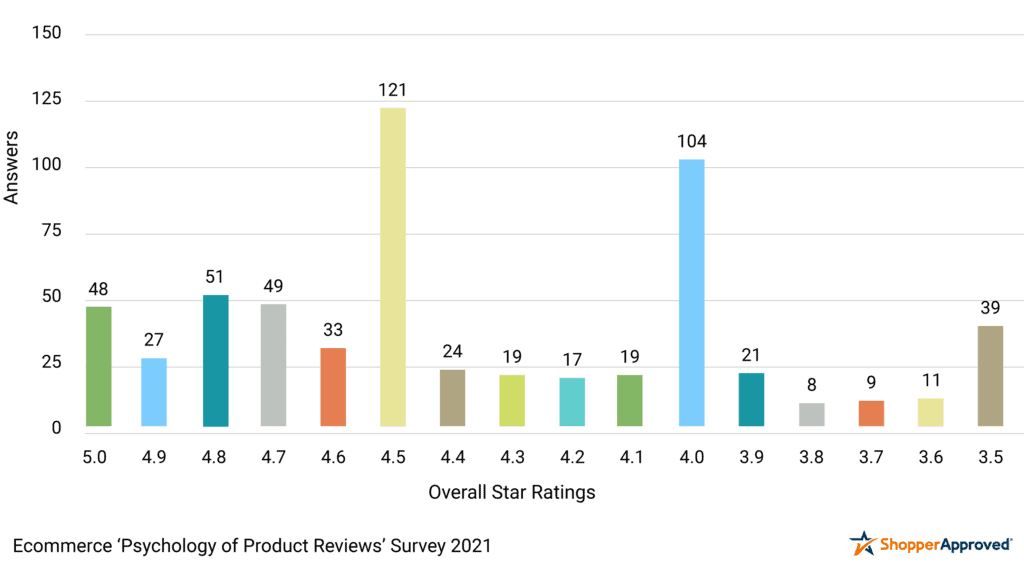
The results showed that as the number of star ratings approached 5 stars, more consumers were willing to buy. However, there were two numbers that really stood out as the minimum rating people were willing to accept: 4 stars and 4.5 stars. This tells us that there are two subsets that makeup 17% and 20% respectively - one being more risk-tolerant (the 4-star subset), and one being more risk-averse (the 4.5-star subset).
This is very eye-opening, because, just like the previous question, if you want to convert the largest number of potential buyers, the higher the star rating you have the more likely they are to buy. And while 1/3rd of potential buyers might be willing to buy a product with 3.5-4 stars, 55% won’t pull the trigger unless your product’s star rating is 4.5 or higher.
On a scale of 1-5, how much does the total number of reviews that a product has, influence your buying decision?
Once we knew what the minimum acceptable rating was, we wanted to know what the consumer’s ideal rating was when looking at product reviews.
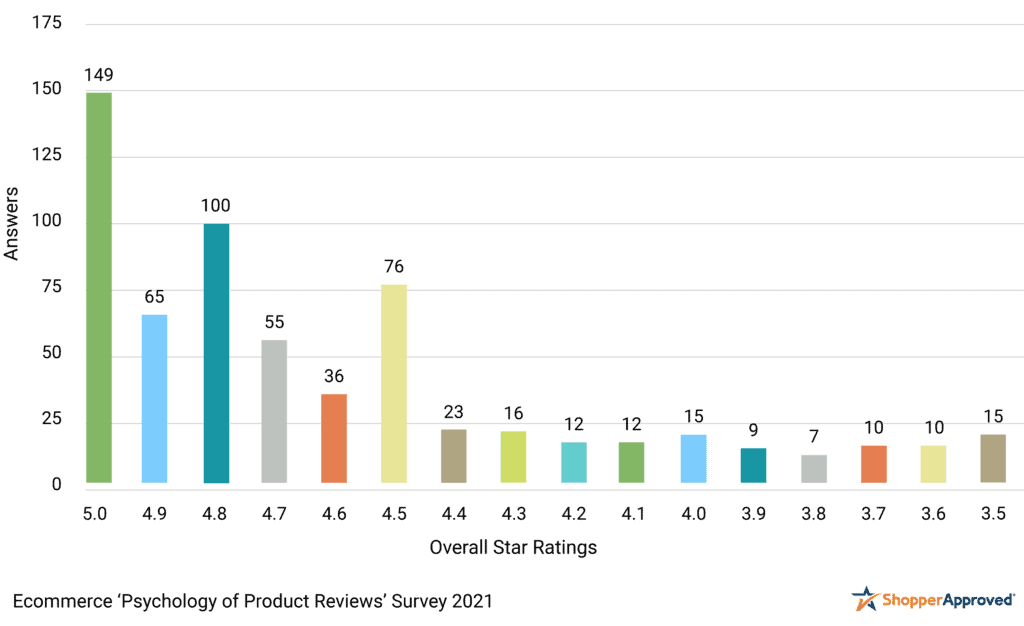
Again, we see a significant increase at the 4.5-star level, with a continued upward trajectory between 4.5 to 5. Once more we see that inherent desire for the ideal 5-star rating come through, with 25% of those surveyed selecting that option. Ultimately, 80% of all consumers, if they had the choice, would choose to buy a product with a rating of 4.5 stars or higher.
When you compare this question to the previous question you can really start to see the difference between what consumers really want, and what they’re willing to settle for if they have to. This is incredibly valuable information, because, the more of your products you can get into this ideal range, the more products you’re going to sell.
On a scale of 1-5, how much does the number of reviews that a product has, influence your buying decision?
This question and the next question were both asked to discover which variable (volume of reviews or star rating) has more influence on a consumer’s buying decision.
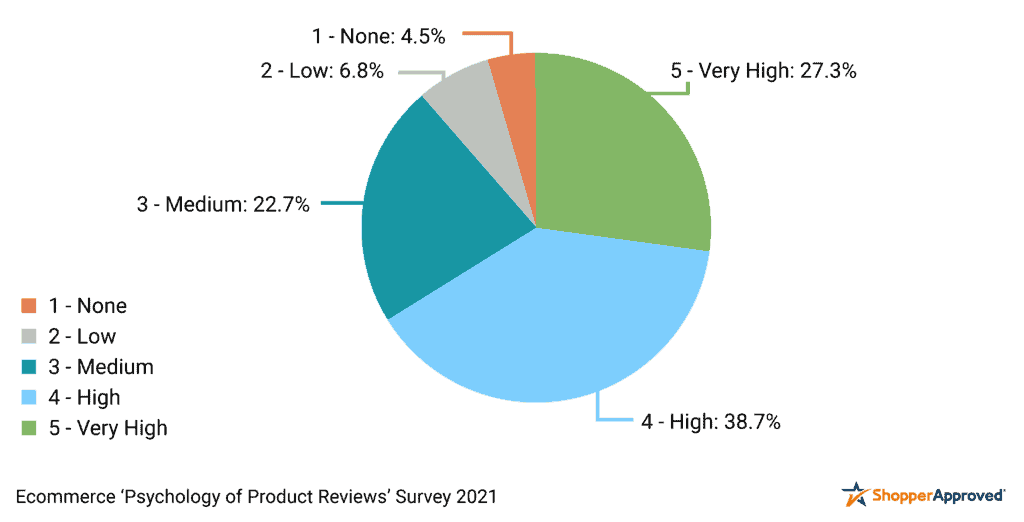
According to the results, 2 out of every 3 people surveyed (66%) said that the total number of product reviews has a ‘High’ to ‘Very High’ influence on their buying decision.
On a scale of 1-5, how much does the overall star rating that a product has, influence your buying decision?
Based on the results to this question, 72% said that the overall star rating has a ‘High’ to ‘Very High’ influence on their buying decision.
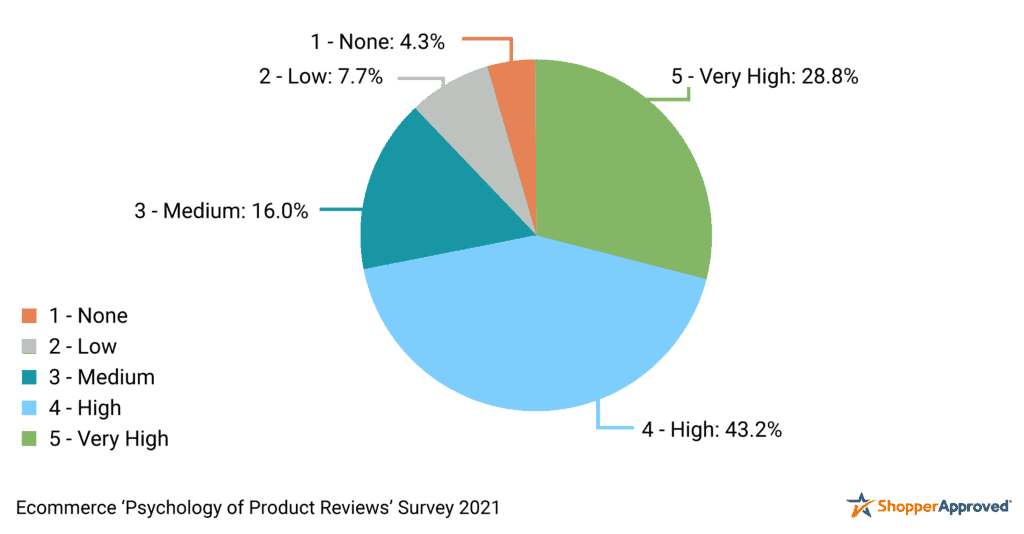
So, when comparing the results of these two questions, star rating does appear to be slightly more important than review quantity, but not by much. There is only a 6% gap in the ratings between the two.
How often do you leave a product review, when asked after making a purchase?
As a final question, we wanted to ask respondents how often they left product reviews after buying online.
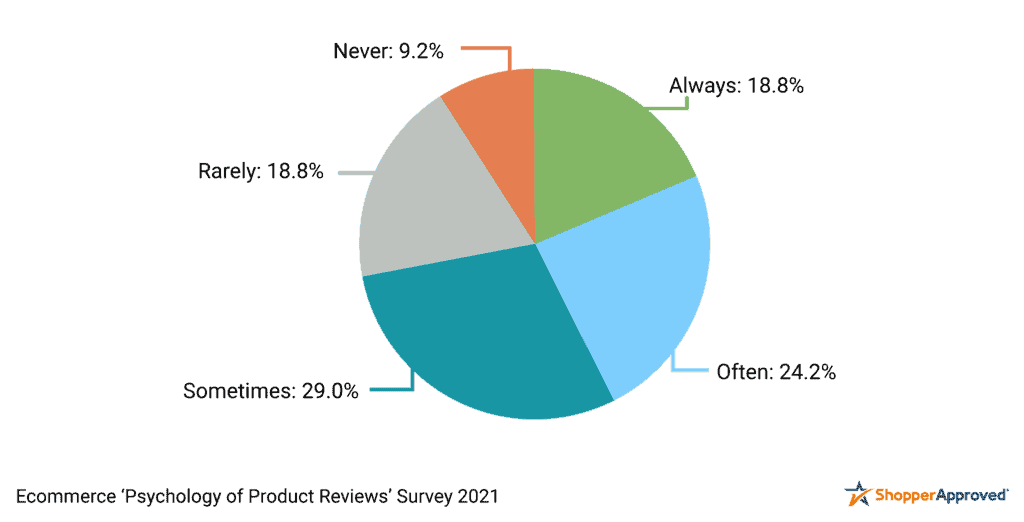
Based on the results, 43% said they leave product reviews ‘Often’ or ‘Always’ when asked. That number increased to 72% when ‘Sometimes’ was added. This is good information to know because sometimes as a merchant, you might feel like you’re putting your customers out if you ask them to leave a review; however, based on the responses above, most are generally willing, and almost expect to do so.
Summary of Findings
In 2021, ratings and reviews are more valuable than ever. Not only do consumers feel like they are incredibly important, but they are also highly influential in many of their decision-making processes.
While a small group of risk-tolerant consumers is willing to buy products online with less than 4.5 stars, most consumers are risk-averse and only buy products that have a 4.5 to 5-star rating. This holds true for products with both high and low quantities of reviews - even if the quantities are massive.
However, when comparing identical products sold by different companies with identical or nearly identical star ratings, quantity becomes very important, and the product with more reviews will win the sale. In addition, when it comes to reviewing quantities, there are 5 types of buyers, who, when their rating minimums are met, are more likely to buy.
While the majority of consumers are willing to buy products with as low as a 4.5-star rating, their ideal star rating is still 5 stars - even knowing that a product having 5-star reviews is likely too good to be true.
Bottom Line:
Star ratings and review quantity are indispensable metrics for consumers when searching for, and ultimately buying products online. The higher the average star rating and review quantities you have for your products, the larger the consumer base you will attract, and the more sales you will make.
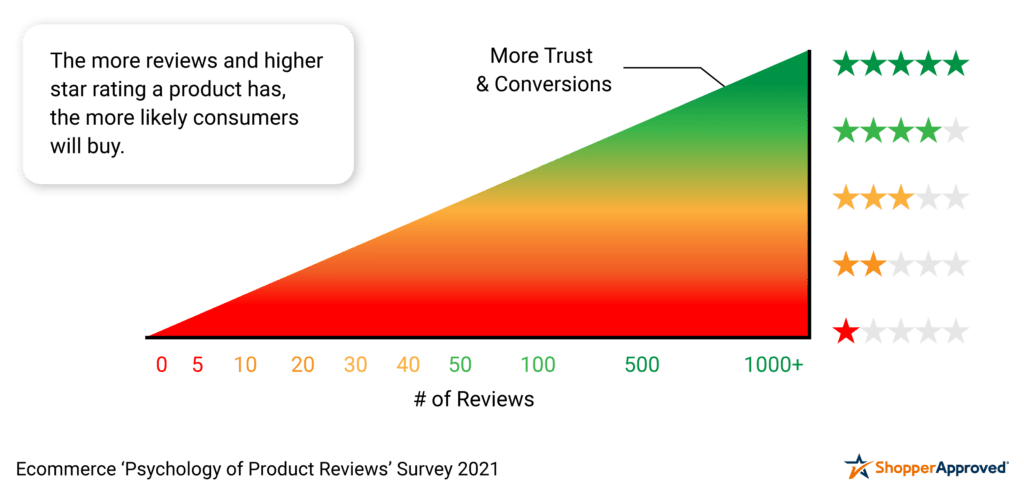
Methodology
This report was generated on behalf of Shopper Approved, in order to explore various ideas and trends in online product reviews; particularly how consumers view the importance of star ratings and the number of reviews based on various scenarios and circumstances.
This survey was given to a representative random sample of 600 US-based consumers, ages 18 and older. It was conducted by an independent 3rd party survey company and was determined to be a statistically accurate representation of the general population with a 95% confidence level and a 5% margin of error.
Reproduction and Use
You are welcome to quote, cite, or use any of the information or graphics in this report, provided that you credit Shopper Approved and link to this URL. If you have any questions or comments about this report, please contact us at support@shopperapproved.com.

 Drive More Visibility, Traffic, and Sales
Drive More Visibility, Traffic, and Sales
